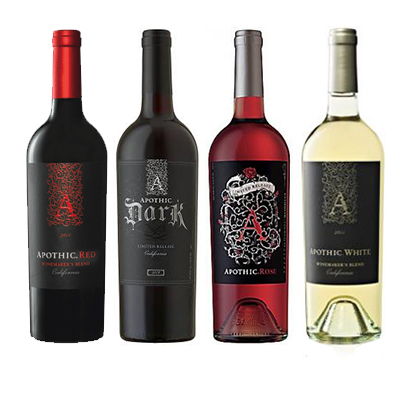 Applicant Kinney Family Vintners LLC DBA Occasio Winery sought to register the mark APOTHEOSIS for several types of red wine but was opposed by E. & J. Gallo Winery. See E. & J. Gallo Winery v. Kinney Family Vinters LLC d/b/a Occasio Winery, Opposition No. 91207656 (March 10, 2015) [not precedential]. Gallo alleged prior use with respect to the mark APOTHIC for wine and argued that the use of Applicant’s mark was likely to cause confusion with Gallo’s mark. Applicant responded, denied the allegations, and asserted an affirmative defense of laches and unclean hands, but such were waived because Applicant failed to prove such at trial. The outcome of the opposition thus resulted on the similarities between the marks APOTHEOSIS and APOTHIC.
Applicant Kinney Family Vintners LLC DBA Occasio Winery sought to register the mark APOTHEOSIS for several types of red wine but was opposed by E. & J. Gallo Winery. See E. & J. Gallo Winery v. Kinney Family Vinters LLC d/b/a Occasio Winery, Opposition No. 91207656 (March 10, 2015) [not precedential]. Gallo alleged prior use with respect to the mark APOTHIC for wine and argued that the use of Applicant’s mark was likely to cause confusion with Gallo’s mark. Applicant responded, denied the allegations, and asserted an affirmative defense of laches and unclean hands, but such were waived because Applicant failed to prove such at trial. The outcome of the opposition thus resulted on the similarities between the marks APOTHEOSIS and APOTHIC.
The parties did not contest that Opposer had used APOTHIC for wine since 2010 and that Applicant filed an Intent to Use application in January of 2012, without claiming or establishing that Applicant had used the mark prior. As a result, the Board based its determination of the likelihood of confusion on an analysis of the similarity of the marks and the relatedness of the goods or services. In such cases, the Opposer bears the burden of establishing likelihood of confusion by a preponderance of the evidence (evidence must be sufficient to determine that the claim is more likely to be true than not).
In its analysis, the Board readily determined that the goods were identical (i.e., both were wines). Id. at 4. Thus, the Board presumed the channels of trade and classes of purchasers would be identical, too. Id. While the Applicant attempted to introduce evidence that its membership system and other methods of sale of its product differentiated the goods, the Board rejected this evidence, asserting it was irrelevant. Id. at 5. The legal identity of the goods and overlapping channels of trade and classes of purchasers weigh in favor of finding a likelihood of confusion, but also decrease the threshold of the similarity of the marks required to be met in order to find likelihood of confusion.
Gallo asserted that its mark was famous, but despite providing a plethora of evidence that might indeed support the fame of the mark, the Board reasoned that it had no context of sales and advertising figures, social media, etc. in regard to how Opposer’s mark might compare to other brands. Id. at 6–7. As a result, the Board declared that Gallo did not prove its mark to be famous but, at the same time, did not provide evidence that its mark was “commercially or conceptually weak” and was at least “fairly strong” and “entitled to a concomitantly broad scope of protection,” thus cutting in favor of finding a likelihood of confusion. Id. at 7.
Thus, the next step the Board took was the analyze the marks in their entireties with respect to sound, appearance, connotation, and commercial impression. In doing so, the Board determined the following:
- The first five letters of both marks are identical (i.e., “APOTH”) and consumers are likely to focus on the first part of the marks;
- The marks look and sound similar due to sharing the same first five letters;
- Applicant’s mark “APOTHEOSIS” means “pinnacle” or “elevation to divine status” or “the perfect example,” and similar;
- Gallo’s mark “APOTHIC” derives from the word “APOTHECA,” which alludes to a place where (more than 800 years ago) vintners would blend and store coveted products in a secretive place called the Apotheca, and Gallo’s word derives from Apotheca combined with the word “epic”;
- Even though Gallo intended its mark to mean one thing, there is no evidence that consumers will understand the meaning behind the word APOTHIC;
- At the same time, APOTHEOSIS is not a commonly used-word and its meaning may not be enough for consumers to distinguish APOTHEOSIS from APOTHIC; and
- Gallo’s APOTHIC mark has been used on a number of the company’s wines, and consumers may associate APOTHEOSIS as an expansion of one of Gallo’s lines.
Id. at 7–10.
As a result, when considered in their entireties, the Board determined that the marks were more similar than dissimilar. Id. at 10. The similarities of the marks with respect to appearance and sound were more significant than perceived differences in connotation, notably in light of the use of the same first five letters and consumer’s familiarity with Gallo’s expanding lines of wines using the APOTHIC mark. As a result, the Board found that Gallo established its claim of priority and likelihood of confusion by a preponderance of the evidence.
For more information on wine or alcohol law, labeling, or trademark, please contact Lindsey Zahn.
DISCLAIMER: This blog post is for general information purposes only, is not intended to constitute legal advice, and no attorney-client relationship results. Please consult your own attorney for legal advice.